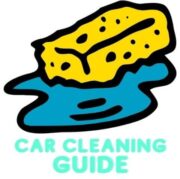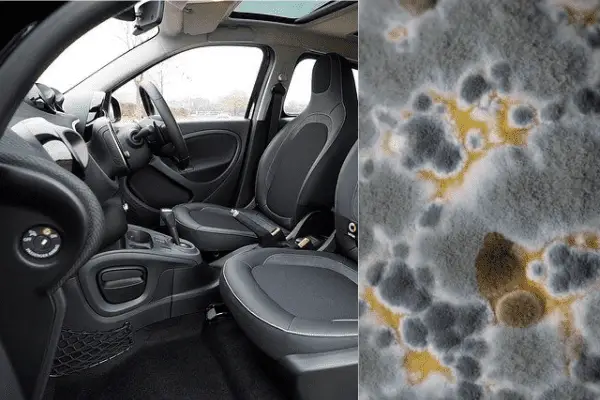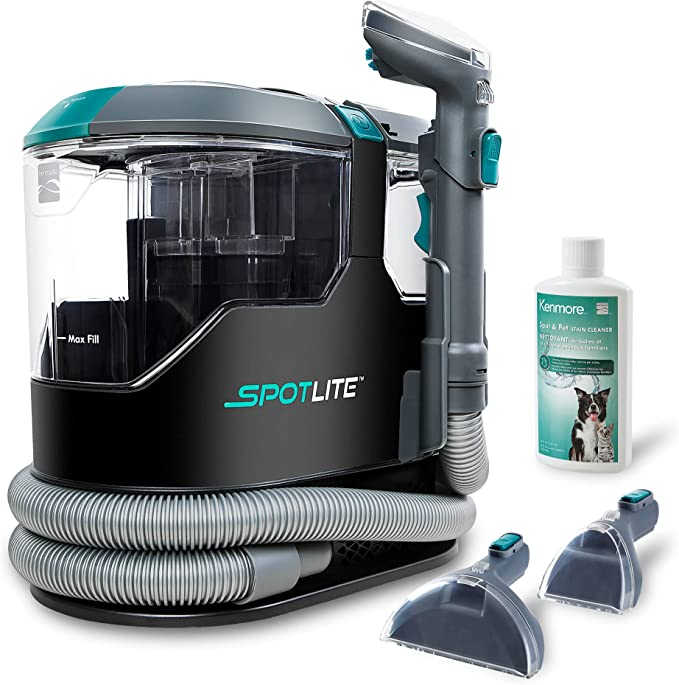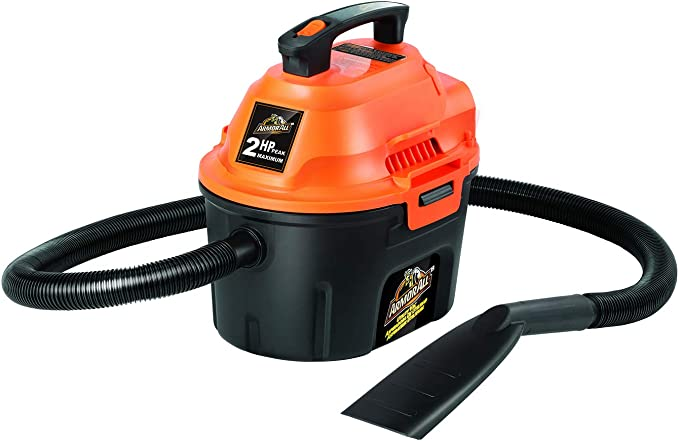Last Updated on July 21, 2023 by Chase Manhattan
I’m severely allergic to mold, and now it’s in my car. What the heck can I do?
I’ve actually asked myself this question. Fortunately for you however, I went down the rabbit hole of solving this problem and I’m here to return the favor to you – without the allergies and sleepless nights.
In this article, I’ll cover what exactly causes a mold infestation, how to identify mold growth, if it’s dangerous or not, and then how to remove mold from your car’s interior, both in general and for each part of your car.
However, beforehand I think it’s important to remind you that certain types of mold can be very dangerous so it’s important to wear proper protective gear when following this guide. When I say proper protective gear, I’m specifically referring to pieces of protecting gear like:
- rubber gloves
- a face mask
- rubber boots
As you may have noticed, the trend here is to offer yourself maximum protection for your exposed skin while reducing the chance that you will pick up mold spores and transfer them to other places.
As a last fore note, I recommend allowing your car to ventilate for at least a few hours after you’ve performed any of the cleaning methods to follow. In most cases, the harmful fumes and chemicals that may be in the car interior will dissipate naturally.
Now, I’m going to cover a few supporting pieces of information that are important to this process but feel free to skip ahead to the guide below.
[Complete Guide to Cleaning Your Car’s Interior]

Quick Navigation
What Causes Mold In a Car?
Mold in a car is caused by excess moisture and the presence of mold spores. Mold spores are microscopic organisms that are present in the air and can easily find their way into a car. When there is excess moisture in the car, either from spills, leaks, or high humidity levels, the mold spores can begin to grow and multiply. This can lead to mold growth on surfaces such as carpets, upholstery, and even inside air conditioning systems. Mold can also cause unpleasant odors and potentially harmful health effects for passengers.
[How to Wax a Car with a Buffer]
Is Mold In a Car Dangerous?
Mold can also cause unpleasant odors and potentially harmful health effects for passengers if they’re continuously inhaling mold spores. Rogue mold spores can cause respiratory problems, allergies, and other health issues in vulnerable parties. Therefore, it is safe to say that mold in a car is indeed dangerous and should be dealt with immediately.
Mold thrives in damp weather and humid environments, making cars exposed to water damage or leaky windows particularly susceptible to mold growth.
[Clean Your Exhaust System the Right Way]
Warning Signs of Mold Growth in a Car Interior
Key warning signs of mold in a car include musty, mold smells, visible dust, and mold growth with a powdery residue on surfaces and water stains on the upholstery or carpeting. It is important to address mold infestations promptly to prevent further damage and potential health risks.
[How to Remove Swirl Marks like a Pro]
What Kills Mold in a Car?
Fortunately, several things kill mold in a car. So, what is it that kills mold in a car? Here’s a list of available items that will kill mold in your car:
- baking soda
- distilled white vinegar
- direct sunlight
- tea tree oil
- clove oil
[How to Clean a Car Covered in Pollen]
Baking soda is a readily available method that will eliminate mold in your car interior. Baking soda naturally absorbs moistures and neutralizes odors, so it will draw this moisture from the cells of the mold therefore killing it for easy removal. This makes baking soda an excellent and natural solution for mold removal in a car interior.
White vinegar is another strong solution that will get rid of mold in your car. Since white vinegar is a readily available substance that can be diluted in a spray bottle, it is a great option for those of us in a rush.
Another practical method to kill mold in your car is to expose your car to direct sunlight. UV rays are a strong source of heat that naturally eliminates moisture. Since mold naturally grows in damp and dark environments, sunlight works to naturally counter act this process.
Clove oil is another natural remedy used to eliminate mold in a car interior. It works similarly to tea tree oils which will eradicate mold, while also working to counteract any lingering odors.
Speaking of tea tree oil, it particularly is a natural anti fungal agent that works to kill and dislodge mold while working to eliminate any bad smells inside your car – much in the same way as clove oil.
Lastly, it’s often the best decision to use a dedicated mold removal product when it’s available to you. In most cases, one of these products can be found at your local auto parts store.

Interior Car Mold Removal: Step by Step Guide
Fortunately, removing mold is not an overly complex process but it will still require some diligence on your end to perform it safely and without damaging your car’s interior.
I will go into each step of the mold removal process and explain exactly what I mean by diligence; but first, here are some items that you will need to get rid of mold in your car interior:
- spray bottle
- vacuum
- an air freshener
- white distilled vinegar solution
- baking soda
- dedicated mold treatment product
Keep in mind that I will show you my preferred method to complete this process, but I will also mention some available variations for your use.
Also, consider this a friendly reminder to wear your safety gear. I’m highly allergic to all forms of mold spores, so this was important to me but mold can affect everyone, so I recommend you take these precautions as well. Here are the pieces of safety gear you’ll need when removing mold from your car:
- rubber gloves
- a face mask
- rubber boots
[How To Clean Any Exhaust Tip]
Prepare the Car’s Interior
For this remediation process to be successful, we will first need to remove all loose items from your car interior. This means removing all trash, personal items, or damp clothes like wet swimming trunks and any loose pieces unaffected by the mold. Proceed, with a vacuum cleaner, to remove all smaller debris or food crumbs that may be present.
I highly recommend taking this chance to examine all of the rubber seals inside your car as the mold infestation in your car interior is most likely due from open exposure to damp weather.
[Best WD40 Substitutes for Car Use]
Treat the Mold Spots with a Spray Bottle
This is likely to be the most important part of the process, aside from keeping the mold away in the first place. You will now treat the mold spots with your mixture of white vinegar in a spray bottle or a dedicated mold treatment product. Alternatively, you can sprinkle baking soda over the affected area as it will eliminate mold spores by drawing oxygen from them. Allow the solution to soak for 30 seconds to 1 minute.
[How to Clean Catalytic Converter]
Agitate the Mold Spores
Using a handheld scrub brush or drill attachment, agitate the mold spots until they’ve broken free then wipe them away with a paper towel or a clean microfiber cloth. Keep in mind, if your mold infestation is severe, you will only be removing the surface mold; you will need to take further steps to remove the mold inside the material unless it’s on a hard surface.
[How To Clean Purge Solenoid Valve]
Apply Car Interior Shampoo
Apply your cleaning solution to the affected area. This will require extensive scrubbing to both remove the stubborn stains and eliminate the risk of a leftover crusty residue. An alternative to using shampoo, apply a few drops of baking soda, clove oil, or tee tree oil to the area and scrub thoroughly after 30 seconds to 1 minute.
[Why You Shouldn’t Drive With a Bad Purge Valve]
Finish with a Vacuum Cleaner
To make sure that you’re entirely removing the mold from your car, I highly recommend finishing this process with a vacuum cleaner. The vacuum will remove any mold inside the upholstery so that you won’t experience a lingering pungent odor or recurring fungus growth.
Alternatively, you can a vacuum cleaner type product that is designed for steam cleaning. Many times, these steam cleaning products are designed for use against pet stains and odors but they function great in a car’s interior as they hold a tank for clean water, and a tank for detergent as well.
Ventilate the Interior
To ensure that the mold spores have been removed from the entire car, I recommend allowing your car to ventilate in a secure area for a few hours. You can do this by leaving the doors open, or by leaving the car windows cracked enough for air to flow in and out.
Avoid doing this is rainy weather unless you have a waterproof cover. In extreme circumstances, mold spores will recirculate into the car’s air conditioning system (essentially the same way as hvac systems function); in turn, this would lead to recurring mold growth in your car.
Lastly, I recommend leaving an air freshener inside the car interior as an additional method to eliminate any lingering pungent odors.

How To Get Mold Out of Car Carpet
Typically, the best way to get mold out of a car’s carpet is to follow the mold removal procedure above and finish up with a steam cleaning. In severe circumstances, it may require you to agitate the area with a firm bristled scrub brush to loosen any stubborn stains.
Before steam cleaning, I would like to reiterate that it’s very important to use a vacuum cleaner to remove any loose debris beforehand. Otherwise, this loose debris runs the risk of holding onto additional moisture, which could later develop into recurring mold growth.
[How to Stop Rust Bubbles from Spreading on Your Car]
Avoiding Mold Growth In Car Carpet
My personal favorite way to avoid mold growth in my car’s carpet is a simple one time purchase of waterproof floor mats. These floor mats will help keep your car clean by preventing any excess moisture from building up in the carpets. Additionally, they can be easily removed, cleaned, and reinstalled for easy maintenance.
[How to Clean Your Car’s Undercarriage]
How to Remove Salt Stains from Car Carpet
Often times, mold growth is accompanied by excess sodium deposits in your car’s carpet. This develops into stains that must be removed.
Here’s how you can remove salt stains from your car’s carpet:
- spray white vinegar onto the stains
- let sit for a few minutes (3-4 maximum)
- use an old rag to clean up the area
- blot dry or vacuum the area
- allow to air dry
[How to Fix a Sunroof That Won’t Close]
How To Clean Mold Off Car Seats
Mold removal for car seats is roughly the same as the procedure outlined above; however, there are a few key differences.
Since car seats often come in contact with human skin, you will want to be sure to avoid using any harmful chemicals as they can irritate skin in sensitive parties. Particularly, the seat belts will need to be cleaned but often hold onto lingering chemicals that may be used during the process.
Additionally, you’ll want to remove any seat covers prior to applying this practice. Seat covers will not allow you to penetrate the upholstery underneath, and may be more difficult to adequately dry.
[Best Car Wash Soap Alternatives]
How To Remove Mold from Rubber
It’s relatively easy to remove mold from your car, even when on rubber surfaces. However, it does require a different approach. Without the need for a vacuum cleaner, I personally prefer to use baking soda and a soft scrub brush to remove the mold.
The baking soda works by drawing the oxygen from the cells of the mold, and since it’s on a rubber surface you can easily wipe it away after with a clean microfiber cloth.
Otherwise, if you’d like to avoid potential abrasion from the baking soda, you can use olive oil to soak and remove the mold from your car.
[How to Properly Dry Your Car with A Leaf Blower]
How To Remove Mold from Your Air Conditioning
Getting rid of mold in your car’s air conditioner follows a different procedure from above but is a relatively passive venture.
Here are the steps to remove mold from your car’s air conditioner:
- dry your car entirely
- apply an anti bacterial spray
- replace your cabin air filter
[How to Remove Scratches from Black Plastic Bumpers]
Best Mold Remover for Car Interior
As I briefly mentioned earlier, my favorite mold remover is actually designed for pet owners. It is a vacuum type product, that also has a steam cleaning function with the ability to hold cleaner water, detergent, and dirty water, in separate tanks during use.
Alternatively, it’s best to follow the procedure above and use a wet/dry vacuum as the last step of the process. My preferred option here is this wet/dry vac from Armor All.
How To Keep Mold from Regrowing In Your Car Interior
As we’ve discussed throughout this article, the number one cause of mold growing in your car interior is the presence of excess moisture. To combat this, I recommend exposing your car to fresh air on a regular basis, but there are a few additional steps you can take here.
Here’s how you can keep mold from growing in your car interior:
- eliminate any leaking window seals
- don’t leave wet garments inside
- repair any broken windows
- air out your car frequently
[Guide for Making Homemade Car Wash Soap]
How To Eliminate Lingering Moldy Smells
The best way to eliminate lingering mold smells will be to leave your car windows, or doors, open enough to ventilate the car. This is best done regularly, but there are a few products available that will speed up this process. The best method being an ozone generator, but there are other alternatives as well.
Here are some good products to remove moldy smells from your car:
- ozium air purifying spray
- an air freshener
- an oil diffuser
- charcoal based air filter
- replacing your air filters
- an ozone generator
[How to Keep Cats Off Your Car]
FAQs and Related Questions

Can WD-40 Remove Mold?
WD40 itself will remove mold from your car, but it is not a sterilizing agent. WD40 alone is a solvent, which is a substance great at dislodging materials from sticky surfaces so it will allow you to brush the mold away but it will not kill any mold spores that remain.
Is White Mold in a Car Dangerous?
White mold in your car isn’t inherently dangerous, but continuous mold exposure over a longer period of time will have adverse effects. Sensitive parties in particularly can experience more negative consequences to mold exposure; consequences such as trouble breathing, rashes, and other allergic reactions.
What Happens if you Get Mold In Your Car?
If you get mold in your car, you’ll first notice some key warning signs such as:
- moldy odor
- mold spots
- fungus growth or loose spores
- sneezing and difficulty breathing
Why Did Mold Grow In My Car?
It’s most likely that mold growing in your car is due to continuous exposure to rainy weather and excessively wet conditions that allow moisture to build up in the car interior.
How Long Does it Take For Mold To Grow in a Car?
Mold can begin growing within 24 – 48 hours. This means that one night of leaving a window down is enough to sustain mold and mildew growth inside your car.




